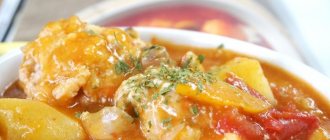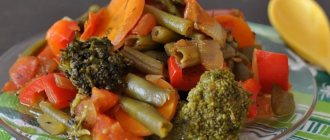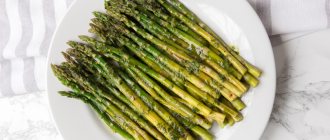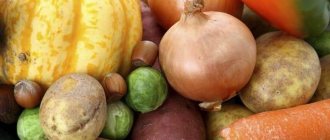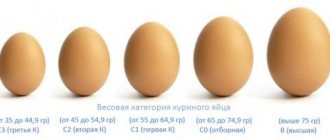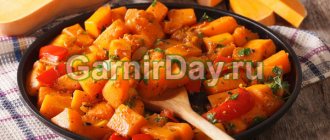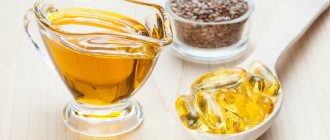Recipe for “Vegetable stew without oil”:
Subscribe to the Povarenka group on VKontakte and receive ten new recipes every day!
Join our group on Odnoklassniki and receive new recipes every day!
Share the recipe with friends:
| BB embed code: BB code is used on forums |
| HTML embed code: HTML code is used in blogs, such as LiveJournal |
How will it look like?
Similar Recipes
Homemade stewed cabbage with beef
- 2
- 118
- 1442
Delicate soufflé “My Pumpkin”
- 57
- 126
- 8411
Turkish eggplant
- 156
- 1738
- 153231
"Pumpkin Boats"
- 10
- 14
- 4524
Chisangi-vegetables in Chinese
- 101
- 201
- 9458
Cauliflower baked in the oven
- 5
- 104
- 2648
Piperada
- 313
- 1873
- 41149
Cauliflower casserole with vegetables and bacon
- 4
- 18
- 1132
Baked potatoes with smoked meats and wild garlic
- 10
- 52
- 1638
Try cooking together
Salad "Snowdrifts"
- 53
- 308
- 55875
Sushi "Sakura"
- 55
- 540
- 124940
Cake “New Year log with cranberries”
- 116
- 276
- 6999
Comments and reviews
- All
- Prescription questions
- Reviews
March 7 patapeika # (recipe author)
March 3 patapeika # (recipe author)
Leave a comment or review about the recipe
Register, or log in if you have already registered.
You can log into the site without registering or entering a password by using your account on the following sites:
Prepared by: Yulia Malchenko
04/10/2018 Cooking time: 1 hour 0 min
| Save | I cooked) | Estimate |
This dish is perfect for healthy eating recipes, as well as for those on the Dukan diet. Vegetables are cooked in a frying pan without adding oil or salt. If you are not on a diet, you can add salt.
Recipe for stewed vegetables without oil and salt. Calorie, chemical composition and nutritional value.
Nutritional value and chemical composition of “stewed vegetables without oil and salt.”
The table shows the nutritional content (calories, proteins, fats, carbohydrates, vitamins and minerals) per 100 grams of edible portion.
| Nutrient | Quantity | Norm** | % of the norm in 100 g | % of the norm in 100 kcal | 100% normal |
| Calorie content | 40.9 kcal | 1684 kcal | 2.4% | 5.9% | 4117 g |
| Squirrels | 0.9 g | 76 g | 1.2% | 2.9% | 8444 g |
| Fats | 1.8 g | 56 g | 3.2% | 7.8% | 3111 g |
| Carbohydrates | 5.1 g | 219 g | 2.3% | 5.6% | 4294 g |
| Organic acids | 5.4 g | ~ | |||
| Alimentary fiber | 1.3 g | 20 g | 6.5% | 15.9% | 1538 g |
| Water | 79.4 g | 2273 g | 3.5% | 8.6% | 2863 g |
| Ash | 0.536 g | ~ | |||
| Vitamins | |||||
| Vitamin A, RE | 1067.1 mcg | 900 mcg | 118.6% | 290% | 84 g |
| Retinol | 1.018 mg | ~ | |||
| beta carotene | 0.296 mg | 5 mg | 5.9% | 14.4% | 1689 g |
| Vitamin B1, thiamine | 0.039 mg | 1.5 mg | 2.6% | 6.4% | 3846 g |
| Vitamin B2, riboflavin | 0.034 mg | 1.8 mg | 1.9% | 4.6% | 5294 g |
| Vitamin B4, choline | 5.79 mg | 500 mg | 1.2% | 2.9% | 8636 g |
| Vitamin B5, pantothenic | 0.161 mg | 5 mg | 3.2% | 7.8% | 3106 g |
| Vitamin B6, pyridoxine | 0.089 mg | 2 mg | 4.5% | 11% | 2247 g |
| Vitamin B9, folates | 9.893 mcg | 400 mcg | 2.5% | 6.1% | 4043 g |
| Vitamin C, ascorbic acid | 14.54 mg | 90 mg | 16.2% | 39.6% | 619 g |
| Vitamin D, calciferol | 0.004 mcg | 10 mcg | 250000 g | ||
| Vitamin E, alpha tocopherol, TE | 0.393 mg | 15 mg | 2.6% | 6.4% | 3817 g |
| Vitamin H, biotin | 0.579 mcg | 50 mcg | 1.2% | 2.9% | 8636 g |
| Vitamin K, phylloquinone | 4.4 mcg | 120 mcg | 3.7% | 9% | 2727 g |
| Vitamin RR, NE | 0.6338 mg | 20 mg | 3.2% | 7.8% | 3156 g |
| Niacin | 0.5 mg | ~ | |||
| Macronutrients | |||||
| Potassium, K | 213.36 mg | 2500 mg | 8.5% | 20.8% | 1172 g |
| Calcium, Ca | 14.34 mg | 1000 mg | 1.4% | 3.4% | 6974 g |
| Silicon, Si | 12.857 mg | 30 mg | 42.9% | 104.9% | 233 g |
| Magnesium, Mg | 14.84 mg | 400 mg | 3.7% | 9% | 2695 g |
| Sodium, Na | 4.95 mg | 1300 mg | 0.4% | 1% | 26263 g |
| Sera, S | 5.23 mg | 1000 mg | 0.5% | 1.2% | 19120 g |
| Phosphorus, P | 20.3 mg | 800 mg | 2.5% | 6.1% | 3941 g |
| Chlorine, Cl | 105 mg | 2300 mg | 4.6% | 11.2% | 2190 g |
| Microelements | |||||
| Aluminium, Al | 112.8 mcg | ~ | |||
| Bor, B | 72 mcg | ~ | |||
| Vanadium, V | 14.3 mcg | ~ | |||
| Iron, Fe | 0.554 mg | 18 mg | 3.1% | 7.6% | 3249 g |
| Yod, I | 1.33 mcg | 150 mcg | 0.9% | 2.2% | 11278 g |
| Cobalt, Co | 2.804 mcg | 10 mcg | 28% | 68.5% | 357 g |
| Lithium, Li | 11.071 mcg | ~ | |||
| Manganese, Mn | 0.1151 mg | 2 mg | 5.8% | 14.2% | 1738 g |
| Copper, Cu | 65.73 mcg | 1000 mcg | 6.6% | 16.1% | 1521 g |
| Molybdenum, Mo | 5.982 mcg | 70 mcg | 8.5% | 20.8% | 1170 g |
| Nickel, Ni | 5.75 mcg | ~ | |||
| Rubidium, Rb | 62.6 mcg | ~ | |||
| Selenium, Se | 0.214 mcg | 55 mcg | 0.4% | 1% | 25701 g |
| Fluorine, F | 15.32 mcg | 4000 mcg | 0.4% | 1% | 26110 g |
| Chromium, Cr | 2.46 mcg | 50 mcg | 4.9% | 12% | 2033 |
| Zinc, Zn | 0.2114 mg | 12 mg | 1.8% | 4.4% | 5676 g |
| Zirconium, Zr | 1.71 mcg | ~ | |||
| Digestible carbohydrates | |||||
| Starch and dextrins | 0.125 g | ~ | |||
| Mono- and disaccharides (sugars) | 3.7 g | max 100 g | |||
| Glucose (dextrose) | 0.571 g | ~ | |||
| Sucrose | 0.25 g | ~ | |||
| Fructose | 0.429 g | ~ | |||
| Essential amino acids | 0.067 g | ~ | |||
| Arginine* | 0.008 g | ~ | |||
| Valin | 0.009 g | ~ | |||
| Histidine* | 0.006 g | ~ | |||
| Isoleucine | 0.009 g | ~ | |||
| Leucine | 0.013 g | ~ | |||
| Lysine | 0.014 g | ~ | |||
| Methionine | 0.003 g | ~ | |||
| Methionine + Cysteine | 0.004 g | ~ | |||
| Threonine | 0.01 g | ~ | |||
| Tryptophan | 0.003 g | ~ | |||
| Phenylalanine | 0.009 g | ~ | |||
| Phenylalanine+Tyrosine | 0.018 g | ~ | |||
| Nonessential amino acids | 0.29 g | ~ | |||
| Alanin | 0.01 g | ~ | |||
| Aspartic acid | 0.049 g | ~ | |||
| Glycine | 0.007 g | ~ | |||
| Glutamic acid | 0.184 g | ~ | |||
| Proline | 0.007 g | ~ | |||
| Serin | 0.009 g | ~ | |||
| Tyrosine | 0.009 g | ~ | |||
| Cysteine | 0.002 g | ~ |
The energy value of stewed vegetables without oil and salt is 40.9 kcal.
Primary Source: Created in the application by the user. Read more.
** This table shows the average levels of vitamins and minerals for an adult. If you want to know the norms taking into account your gender, age and other factors, then use the “My Healthy Diet” application.
How to cook “Vegetables with mushrooms without oil”
1. For this dish you can use not only mushrooms, but also any meat. I chose the first option because I was preparing a dish for the Dukan diet. Champignons are a purely protein product that cooks very quickly.
2. Place the chopped mushrooms in a hot frying pan. Don't add oil! Reduce heat and fry with constant stirring for a couple of minutes, then add chopped onion.
3. Since I prepared this dish in winter, I had frozen vegetables. This is even better because during frying they released their juices and all the ingredients stewed in their own juices.
4. Chop the carrots and cabbage, add them to the rest of the vegetables and fry with constant stirring.
5. Add tomatoes and fry further.
6. Added Italian herbs and spring herbs for spices.
7. When the vegetables release their juice, cover with a lid and simmer over low heat.
8. Cauliflower should be added at the moment when the vegetables begin to stew. Cut the inflorescences into pieces, this will help the cabbage cook faster.
9. The water will gradually begin to evaporate. Add more if necessary (until the cabbage is done).
10. When the cabbage is soft, you can remove it from the heat. Greens can be added to taste.
11. Serve the dish hot, regardless of the time of day.
Stew or fry: what is the best way to cook vegetables?
What will happen if I fry this delicious eggplant? Will the tomato retain all its wonderful properties if I add oil to the pan? Today we will tell you how best to cook vegetables in order to preserve the maximum of nutrients and nutrients. First, let's figure out what the difference is between stewing and frying.
Oil vs liquid
When braising, you use liquid, and when frying, you use oil or fat. Accordingly, during stewing you avoid the formation of carcinogens that are released from the oil during heating. By the way, a nice bonus is that adding water reduces the risk of the dish burning.
Temperature vs languor
The second difference is that during stewing, when the dish is simmered over low heat, beneficial nutrients are preserved, which are simply destroyed at high temperatures. For example, stewed mini broccoli contains 40% more vitamins than boiled one. Also consider the size of the vegetable: the larger they are cut, the less vitamins they lose.
So what, don't fry now? How crispy is the crust?! Don't be scared! You can fry, but be careful!
How to properly fry vegetables?
1. First of all, do not lean on the oil. It is high in fat, calories and, as we said above, it releases carcinogens when heated. Remember, oil is not a product you should skimp on, because it is about your health. Use only natural and high-quality oil. Note to the hostess: frying mixture with potatoes, beans and bacon - 10 minutes, and a complete finished dish is on the table! Or a compromise with the devil: grilled eggplant and zucchini. Invite your guests!
2. Before frying, steam the vegetables thoroughly, and only then place them in the frying pan. Not for long! Don't turn vegetables into charcoal, because the light crust is exactly what we appreciate this taste for! Alternatively, take steamed green beans and fry them for 1-2 minutes. Fast, tasty and healthy!
3. Use a non-stick frying pan with a thick bottom, high-density walls and a lid. On such a surface, food will not burn, and you can do without oil. Another way is to use parchment, sleeve, foil or paper that is placed at the bottom of the container. Diet food with low calorie content is guaranteed to you!
Stewed vegetable dishes
If you decide to stew vegetables, here are some recommendations.
Vegetable arsenal
The most delicious and nutritious dishes are made from zucchini, white cabbage (everyone remembers stewed cabbage from kindergarten) and cauliflower, potatoes, carrots, sweet peppers and onions. You can prepare a quick and easy side dish or a full meal for dinner using already chopped broccoli, cauliflower and carrots. It is enough to simmer the vegetable mixture for a couple of minutes in a frying pan with a little water or in chicken broth, otherwise it will become too watery. Thin green beans make an appetizing and healthy side dish. The ends are already trimmed, so you will save your precious time!
How long to simmer
Vegetables are also prepared in different ways. For example, carrots, potatoes and cabbage need 20-30 minutes to be fully prepared - they are added first. Next come beets, green beans, onions - these vegetables are stewed for no longer than 15 minutes. At the very end, add tomatoes, zucchini or even sweet corn - they only need about 5 minutes. Don't forget to use spices, and pour olive oil on the plate with the finished dish, sprinkle with fresh herbs or even Parmesan! That's all for now! Do not forget that although raw plant foods contain more vitamins, it is from the stewed form that the beneficial substances are better absorbed. Moreover, if you don’t have a slow cooker, you can simply and quickly bake vegetables in the oven on a baking sheet or prepare a delicious stew of seasonal vegetables in pots.
How to properly stew vegetables
Stewed vegetables are a dish known to everyone. To add an exquisite taste to simple dishes, you can stew vegetables in unique signature sauces with the addition of various spices. It is in stewed dishes that a real cook can demonstrate all his skills, revealing the unique taste of each vegetable or balancing all vegetable flavors.
What are the benefits of stewed vegetables?
Stewing is one of the types of heat treatment of foods, which is used in the preparation of regular and dietary dishes.
The main advantages of cooking vegetables using stewing:
- Minimal or no fat. Usually vegetables are stewed in their own juice or with the addition of a small amount of broth. Therefore, stewed vegetable dishes contain practically no vegetable and animal fats compared to fried ones. When fried, vegetables absorb large amounts of fat.
- Stewed vegetable dishes always turn out juicy and flavorful. Boiled and steamed vegetables don't always have the richest flavor, and fried foods often turn out a little dry and require additional sauces.
- Preservation of the maximum amount of nutrients. When vegetables are stewed, a rich broth is formed, which evaporates only a little. Unlike cooking vegetables, the resulting broth is not drained before serving the dish.
But, like other cooking technologies, stewing also has some disadvantages:
- Loss of vitamins. With any heat treatment, vegetables lose some of their vitamins, micro- and macroelements. During short-term stewing, the beneficial nutritional composition of vegetables remains virtually unchanged, but during prolonged stewing, the beneficial substances decompose, leaving only carbohydrates and fiber in the vegetables.
- To enhance the flavor, vegetables are often fried before stewing, which leads to an increase in fat in the finished dish and high calorie content.
What vegetables can be stewed and in what ways?
You can stew almost all vegetables of the vegetative and fruit groups.
The first group includes: potatoes, carrots, beets, sweet potatoes, celery root, onions and leeks, sorrel. Cabbage: white cabbage, Brussels sprouts, cauliflower, broccoli. Enhance the taste of stewed dishes with herbs such as dill, parsley, savory, basil, lemon balm or mint.
Fruit vegetables suitable for stewing: all types of tomatoes, eggplants, peppers, pumpkin, zucchini, zucchini, fresh green peas. Many stews also contain beans or legumes, but their cooking time until fully cooked is too long compared to vegetables. Therefore, they are added ready-made.
Methods for stewing vegetables
You can prepare stews using various utensils and cooking methods. This can be an open fire, cooking on an electric or gas stove, or baking in the oven.
Depending on the cooking method, vegetables are stewed in a frying pan, cast iron and ceramic dishes, clay pots, or in a slow cooker.
Pros and cons of each cooking method
Stewing in a frying pan
usually used for preparing small portions and after pre-frying vegetables.
Pros: the vegetables turn out juicy and cook quickly.
Cons: the dish may burn, you need to monitor the evaporation of the liquid.
When cooking over an open fire
It is more advisable to use cast iron cauldrons with a lid and thick walls.
Pros: In such dishes, vegetables will not burn, they will retain their juiciness and acquire a unique taste.
Cons: Cooking takes a long time and requires a lot of attention.
For preparing stewed vegetables in the oven
use cast iron molds and ceramic dishes. Dishes are baked in small clay pots in portions.
Pros: in such dishes, vegetables acquire a rich taste and aroma, and when served they look appetizing and original.
Disadvantages: dishes take a long time to simmer; liquid must be added during cooking.
Multicooker
– one of the best helpers when preparing a delicious stewed vegetable dish.
Pros: Minimal time investment, complete lack of control. With this kind of stewing, vegetables cook quickly and turn out juicy with a rich taste and aroma.
Cons: Some vegetables lose their vibrant color.
Regardless of the preparation, when serving the dish, you can garnish it with fresh herbs or top it with your favorite sauce.
Delicious stewed vegetables
By stewing vegetables, you can prepare both simple side dishes and complex independent dishes. To prepare simple dishes, use one type of vegetable or combine vegetables, which are stewed until fully cooked in the same amount of time. Usually all the components of such a vegetable platter are prepared at the same time. Often such dishes are included in the diet menu.
Complex dishes include stews, vegetables stewed with meat, mushrooms and fish. They are prepared in several stages. Each component product requires preliminary preparation: boiling, pickling, stewing or frying. All ingredients are mixed in a semi-finished state and brought to readiness in any convenient way. These dishes have a richer taste and appetizing appearance and higher calorie content.
Stewed vegetables - delicious recipes
Broccoli casserole with fish
- broccoli 350 g,
- potatoes 3 pcs,
- cream 170 g,
- chicken egg 3 pcs,
- fresh red fish,
- hard cheese 100 g,
- nutmeg 5 g.
Preparation: divide the cabbage into inflorescences and boil for three minutes in salted water, boil the potatoes in their skins until half cooked, combine the eggs with cream, salt and nutmeg, and beat with a whisk. Peel the potatoes, cut into large rings, place in a baking dish, lay the cabbage on top, pour in the egg mixture. Bake in the oven at 200˚C for 20 minutes. Sprinkle the hot dish with cheese. Serve in portions hot or cold.
Vegetable sauté with mushrooms
- Bulgarian pepper,
- eggplants,
- zucchini,
- carrot,
- pepper,
- tomatoes. All vegetables 250 g.
- Champignon mushrooms 300 g.
- Garlic 3 cloves,
- salt,
- vegetable oil 70 g,
- water or broth 200 ml.
Preparation: cut the vegetables and mushrooms into rings 5mm thick, salt the blue ones with 1 teaspoon of salt and set aside for half an hour, then rinse and dry with a paper towel. Fry mushrooms and vegetables one by one until golden brown and place in a cauldron. Pour in broth. Bring to a boil and cook over low heat until tender, about 20 minutes. At the end of cooking, add garlic. Serve in portions, garnished with herbs.
Stewing is one of the favorite cooking methods not only of professional chefs, but also of novice cooks because vegetable stews are very difficult to spoil. Even the most unexpected combinations of ingredients result in mouth-watering dishes with an original taste.
How to stew vegetables correctly - Vegetables, herbs, Recipes, tips, descriptions, reviews
Stewed vegetables are a dish known to everyone. To add an exquisite taste to simple dishes, you can stew vegetables in unique signature sauces with the addition of various spices. It is in stewed dishes that a real cook can demonstrate all his skills, revealing the unique taste of each vegetable or balancing all vegetable flavors. Content:
In Russian national cuisine there are many ways of cooking: food is boiled, stewed, baked, fried, poached. Almost all of these methods do not require the addition of oil. Even frying food has long been possible without it: all thanks to cookware with non-stick coating.
Why do many housewives still add vegetable oil or butter everywhere? “It enhances the taste of the dish; fatty foods seem to taste better to us.”
,” explains Daria Rusakova, Ph.D., researcher at the clinic of the Federal State Budgetary Institution “Research Institute of Nutrition”, scientific consultant at the clinic “Nutrition and Health.”
As we know, fats play an important role in the formation of hormones and the absorption of vitamins. They make up the cell membrane, and without fats, oxygen exchange in the lungs would be impossible. Therefore, of course, you should not completely exclude oil from your diet. “It will be more useful to add it to the finished dish. The way we usually fill it up. When heated, oils lose their beneficial properties and even become carcinogenic.”
, - recommends Daria Rusakova.
If you regularly eat fish, meat, poultry, dairy products and nuts, your body will get all the necessary fats from these foods. So don't be afraid of a deficiency of an important nutrient. The habit of cooking without adding oils will be useful not only for people with cardiovascular diseases, atherosclerosis and excess weight, but also for those who can boast of good health. Here are some popular ways to cook without oil.
Cooking in a slow cooker
- Peel the zucchini and cut into cubes.
- Cut the onion into half rings and the tomatoes into cubes.
- Grind the carrots on a coarse grater.
- Drain the liquid from the beans.
- Grind the cheese on a grater.
- Then take a multicooker bowl, pour sunflower oil into it, add vegetables, except beans and tomatoes, cook for fifteen minutes in the “Frying” mode.
- Next add tomatoes and beans.
- Salt and pepper the dish.
- Mix beaten egg with sour cream. Pour the mixture over the stew.
- Place zucchini (in circles) and cherry tomatoes on top as decoration.
- Next, close the multicooker and cook for 45 minutes in the “Baking” mode.
- After 35 minutes, sprinkle the zucchini with herbs and grated cheese. Also, during the cooking process, add bay leaves, garlic and spices to your liking.
Lenten dishes without oil
Lent is not only a time for spiritual, but also for physical cleansing. For those who do not strictly adhere to fasting, it is allowed to prepare dishes with a small amount of vegetable oil.
Many people worry that they will have to eat tasteless dishes, but this is not entirely true, because today there are simply a huge number of easy-to-prepare Lenten recipes that do not require the addition of vegetable oil. Such lean dishes without oil turn out to be quite filling and at the same time, dietary, thanks to which, by adhering to fasting, you can also get rid of a couple of extra pounds.
Buckwheat with mushrooms, cooked in pots
Cooking in pots is not only very convenient, but also delicious, because such dishes will remain hot much longer, which is convenient if relatives do not have time to arrive in time for dinner. It will be enough to simply leave the pots in the switched off oven. Buckwheat with carrots, mushrooms and fried onions turns out incredibly tasty, tender, satisfying and aromatic. This is simply an ideal dish for those who strictly adhere to fasting, since you do not need to use vegetable oil to prepare it.
Ingredients:
2 tbsp. water (cold!), 1 small carrot, 2 onions, 500 g champignons (fresh!), 1 tbsp. buckwheat, salt - a little, to taste.
Preparation:
First, we prepare the champignons - wash the mushrooms thoroughly and cut them into small slices. Peel the carrots, wash and chop on a coarse grater, cut the onion into small cubes.
Place a frying pan on the stove, heat it thoroughly, lightly fry the carrots, onions and mushrooms. There is no need to add oil, as the mushrooms will quickly release their juice, but you must be careful to ensure that the onions do not burn.
While the vegetables are frying, we prepare the buckwheat. Rinse the buckwheat thoroughly with cold water several times until the water is perfectly clear.
As soon as the vegetables are ready (they need to be fried for about 10 minutes), mix them with washed buckwheat, lightly season with salt and place in prepared pots, while pouring out all the juice that the mushrooms release. And then pour plain water into the pots, since the buckwheat with vegetables should be completely covered with liquid.
Place the pots in an oven preheated to 180 degrees and leave for exactly one hour.
Lenten buckwheat with mushrooms in pots is ready and can be served. The amount of ingredients is designed for two servings, so if guests are expected for dinner, it is worth remembering this.
Lean vegetables cooked in pots
During Lent, it is allowed to consume vegetable oil only on weekends, and on other days only lean dishes without oil. On weekdays, you can cook very tasty, tender and satisfying vegetables in pots without adding oil.
Ingredients:
4 tbsp. l. tomato paste, 1 large onion, 1 large carrot, 4 small tomatoes, 1 bell pepper (preferably using red pepper), 1 small zucchini, garlic cloves, bay leaf and salt - a little, to taste.
Preparation:
First, we take the zucchini and peel the peel, as it will give off bitterness, after which we cut the zucchini into half rings. We cut carrots and tomatoes into not very large cubes, cut the onion into half rings. Place all prepared vegetables in a separate bowl and mix, lightly season with salt.
We dilute tomato paste in a small amount of water. Next, take the salted vegetables and transfer them to pre-prepared pots. This amount of vegetables can be distributed into two not very large pots or cooked in one large one, whichever is more convenient for you.
Now pour the diluted tomato paste over the vegetables - it is important to ensure that the water in the pots almost completely covers all the vegetables, and only a small top remains above the water.
If necessary, you can add a little water until the desired level is achieved. Now lightly salt the vegetables again, mix everything thoroughly and place the pots in an oven preheated to 180 degrees. If the dish is prepared in two small pots, then the cooking time will be about an hour, and if in one large one, then two hours.
About 15 minutes before the end of cooking, add a bay leaf to the vegetables in the pots, and as soon as the dish is ready, squeeze the garlic into the vegetables (literally one clove).
Salad with apple, pumpkin and walnuts
Even during Lent, you can prepare a delicious dietary salad, rich in valuable vitamins that are so necessary for the body during this period. The salad prepared according to this recipe turns out incredibly tasty, tender, juicy and appetizing, so it is ideal not only for fasting people, but also for those who regularly follow various diets, since it contains virtually no calories.
Ingredients:
1 handful of walnuts, 1 tbsp. l. honey (less or a little more), 1 lemon, 4 sweet apples, 500 g raw pumpkin.
Preparation:
First, we prepare the pumpkin - peel the skin, and then grind the pulp on a coarse grater. Take an apple, wash it, peel it, remove the core, and grate it on a coarse grater. Next, take the walnuts and chop them (you can grind the nuts in a mortar), but not too finely.
In a separate container, mix apples, pumpkin pulp, nuts, add the juice of one lemon and slightly sweeten with liquid honey (the amount of honey depends on your own taste preferences, if desired, you can omit it at all). Mix all ingredients thoroughly, then transfer to a salad bowl, and you can serve.
Lenten salad with cabbage
This salad turns out to be very tasty, tender and dietary, it is prepared without adding vegetable oil, so it is simply ideal for a Lenten table.
Ingredients:
2 or 3 pitted prunes, 400 g white cabbage, 1 small carrot, lemon zest, sugar and salt - a little, to taste.
Preparation:
Take the cabbage and cut it into small strips, then add one small pinch of salt, lightly season with sugar, and then mix everything with your hands and during this process lightly knead the cabbage, thanks to which it will become more tender and soft and release the juice.
To keep the prunes soft, they must be soaked in advance and then cut into thin strips. Peel the carrots and chop them on a fine grater. Grind the lemon zest in the same way (you will need the zest of half a lemon).
In a separate container, combine all the ingredients, mix everything well, and you can serve the dish.
Diet beans
Beans prepared according to this recipe are simply ideal for a Lenten table, they are easy to prepare, and the result is a delicious dish with a minimum amount of calories.
Ingredients:
1 bunch of fresh herbs, 1 large onion, 2 tbsp. colored beans.
Preparation:
First, we prepare the colored beans - fill them with hot water (it is best to use boiling water) so that all the top beans are covered, then cook the beans until they are fully cooked (until they become soft). Season with a little salt, add the onion, cut into small cubes, and cook the beans for another half hour.
Before serving, add chopped herbs - the dietary beans are ready.
Lenten cabbage soup with mushrooms
To eat tasty and healthy dishes even during Lent, you should try preparing cabbage soup with mushrooms according to the following recipe.
Ingredients:
1 parsley root, 1 small carrot, 2 medium onions, 3-5 potato tubers, 25 g of dried mushrooms, 500 g of sauerkraut, salt, fresh herbs, garlic - a little, to taste.
Preparation:
First, we take the dried mushrooms and fill them with hot water, wait until they become soft (this procedure must be repeated two or three times), and then transfer them to a saucepan. Pour cold water into a saucepan and put it on the stove, cook the mushrooms for about half an hour, as the mushroom broth should be well cooked.
Peel the potatoes, wash them and cut them into small slices. Clean and finely chop the onion. We peel the parsley root and carrots, wash them, and then chop them - you can cut them into small cubes or chop them on a coarse grater (here it all depends on personal preference).
As soon as the mushroom broth is ready, put the prepared vegetables in a saucepan, add a small amount of salt and spices.
Squeeze the sauerkraut thoroughly (if the cabbage is very salty, then rinse it under cold water to remove all excess salt), then transfer it to a saucepan.
As soon as the potatoes are completely cooked and all the vegetables are thoroughly cooked, remove the saucepan from the stove and add a garlic clove passed through a press.
The cabbage soup is completely ready and can be served.
Lenten apple pie
This pie is simply a godsend for people who strictly adhere to Lent. The pie prepared according to this recipe turns out incredibly tasty, tender and aromatic. And no one can even think that it was prepared without adding vegetable oil.
Ingredients:
1 kg sweet apples, 1 tsp. baking powder, 1 tbsp. sugar, 1 tsp. chopped cinnamon, 1 tbsp. semolina, 1 tbsp. sifted flour, apricot jam, liquid honey, poppy seeds and nuts - a little, to taste.
Preparation:
In a separate container, mix all dry ingredients.
Wash and peel the apples, then chop them on a coarse grater, add poppy seeds and nuts.
Take a baking dish and sprinkle the bottom with a few tablespoons of the dry mixture, spreading in an even layer.
Now put a layer of grated apples on top, pour a small amount of liquid honey on top. Thus, we lay out several layers, and the last layer should be from a dry mixture (there should not be very much of the mixture, since the crust can turn out to be very hard).
Place the pie in a well-heated oven and bake for 50 minutes, after which we remove the pan from the oven and leave for a while. Once the cake has cooled slightly, spread a small amount of apricot jam on top and you are ready to serve.
Lenten potato soup with garlic
This potato soup is prepared very quickly and quite easily, and the dish turns out appetizing and quite filling.
Ingredients:
4 small potato tubers, 2 liters of vegetable broth, 2 small heads of garlic, ground black pepper, salt and herbs - a little, to taste.
Preparation:
Don’t worry that the recipe contains a large amount of garlic; the result is a dish with a delicate aroma and delicious taste.
First, turn on the oven; it should have time to warm up to 190 degrees. Place the garlic on a baking sheet and leave in the oven for half an hour. As soon as the garlic becomes soft in the middle, you can take it out.
Peel the potatoes, wash them and cut them into not very small cubes. Place the potatoes in a large saucepan and cook until half cooked, season lightly with salt.
Cook the broth for 5 minutes, then drain the potatoes and add them to the broth.
Peel the garlic cloves, press them using a press and leave a few cloves to decorate the dish. Add garlic to the soup and cook for about a quarter of an hour, after which we can pour the soup into plates, decorate with garlic cloves and serve to guests.
As you can see, lean dishes without oil are no less tasty. Bon appetit!
Elena Malyk
Vegetable stew in a slow cooker
You want to cook steamed vegetables in a slow cooker. Didn't you like the recipes above? Then we offer another one. Now we will describe the technology for preparing stew. To create this yummy dish you will need a minimum of time and effort, as well as this slow cooker vegetable recipe.
Ingredients for the stew:
- carrots - two pieces;
- two cloves of garlic;
- canned tomatoes - 400 grams;
- vegetable broth - a glass;
- zucchini, onion and eggplant - one each;
- sunflower oil - three tablespoons;
- parsley - two sprigs;
- salt;
- ground cumin - teaspoon;
- ground black pepper.
Cooking stew in a slow cooker:
- Wash the eggplant, cut into cubes, place in a bowl, add salt and leave for half an hour.
- Do the same with the zucchini.
- Wash, peel, dry and cut the carrots into slices.
- Peel the onion and cut into half rings.
- Wash the parsley and separate it into leaves.
- Pour three tablespoons of sunflower oil into the bowl of the device, turn on the “Multi-cook”, set the temperature to 160 degrees.
- Heat the oil, add the onion, fry for five minutes.
- Next, add ground cumin, carrots, tomato pulp, eggplant, and garlic. Mix all ingredients and cook for another five minutes.
- Then pour the broth into the bowl, bring to a boil, add pepper, salt, zucchini and parsley.
- Simmer for another ten minutes. Next, place the dish on plates.
Stewed vegetables in a slow cooker: recipes
The next dish we will look at will be quite unusual. It's possible that you've never even tried it. If this is the case, then be sure to take note of this recipe for vegetables in a slow cooker.
Now we will look at the stages of preparing zucchini with beans in sour cream sauce. For cooking you will need:
- canned beans - one can;
- carrots and zucchini - one piece each;
- onion and tomato – one each;
- sour cream - two hundred grams;
- hard cheese - one hundred grams;
- greenery;
- egg;
- salt;
- ground black pepper;
- sunflower oil - a tablespoon.
Which vegetables can you eat when losing weight, even without restrictions, and which should not be consumed when dieting?
Prepared dishes from vegetables for weight loss are not inferior in taste to rich soup and stewed potatoes. Low calorie content, high content of vitamins and microelements - this is not a complete list of the advantages of this diet. How to lose weight on vegetables Losing weight quickly on vegetables is real, hundreds of people have experienced this effective menu. After going through a vegetable diet, a person feels much better and loses several kilos in a week. Due to its high fiber content, dietary fiber absorbs toxins, the product helps remove toxins, cleanse the body, and helps improve digestion. Vegetables contain a small amount of carbohydrates, but are well saturated.
Vary your potatoes and zucchini with peas, Brussels sprouts, celery or artichokes.
Vegetable stew is a universal dish that will develop your culinary imagination. You can combine any vegetables. The main thing is to remember a few rules.
The benefits of stewed vegetables
This cooking method is considered the most gentle. During the process of cooking, baking, blanching and other heat treatment methods, most of the valuable vitamins, minerals and trace elements are lost. Eating stewed vegetables is especially useful for gastritis and gastric ulcers. In addition, this food is recommended for overweight people and diabetics.
Vegetable stew. Calorie content per 100 grams
Stewed vegetables, the calorie content of which depends on the processing method, have the following advantages:
- high content of vitamins, minerals and microelements, especially necessary during the diet;
- cooking without using oil guarantees low calorie content of the dish;
- during heat treatment they do not lose fiber, which helps quickly saturate and cleanse the body;
- Due to the low carbohydrate content, weight loss occurs faster, while the liver is not overloaded.
